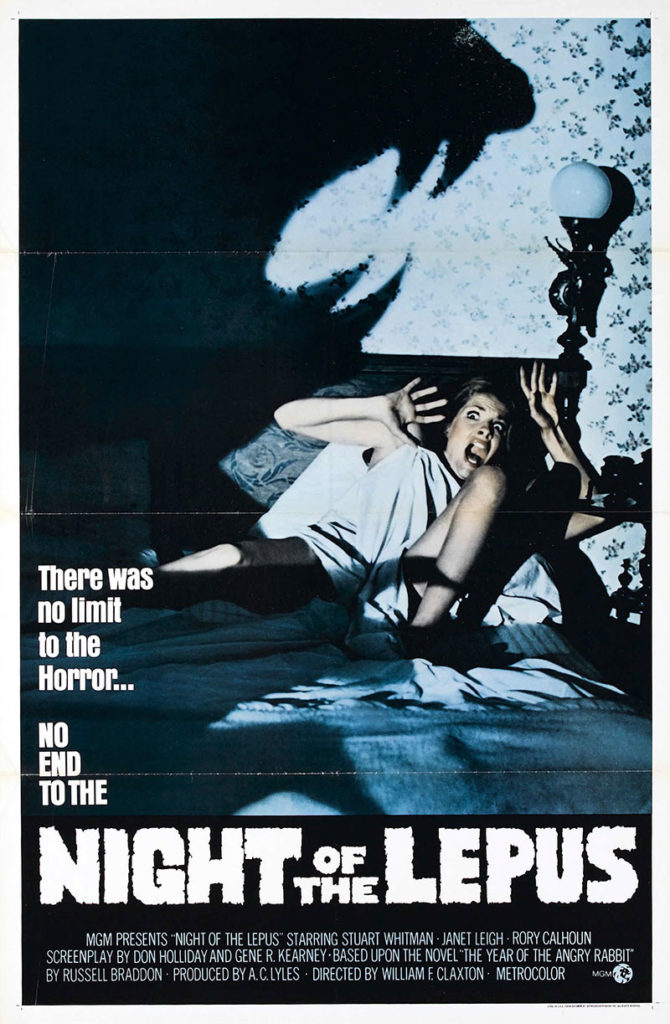The October Horrorshow Giant Monstershow carries on with one of the most ridiculous premises one can come across in film. Night of the Lepus, a terrifying tale of nature run amok after the arrogant interference of man, is about a plague of giant rabbits. Cute, cuddly, merciless and carnivorous rabbits. No matter how serious those involved treat this material, it’s impossible to get around the fact that the bad beasties in this flick are bunny rabbits.
From 1972, Night of the Lepus was helmed by veteran television director William F. Claxton. Claxton was a regular behind the camera for the hit show Bonanza at the time. His extensive experience directing television shows is apparent to viewers who remember television of the day. In fact, were it not for the occasional gore shots in this flick, the film could be mistaken for a Sunday night TV movie on one of the big three networks.
The film follows university researchers Roy and Gerry Bennett (Stuart Whitman and Janet Leigh). They’ve been studying bats in rural Arizona, when their college president, Elgin Clark (DeForest Kelley), recruits them to help out a local rancher. The rancher, Cole Hillman (Rory Calhoun), has been dealing with thousands of rabbits that have invaded his land, ruining it for his grazing cattle. Hillman wants to avoid using cyanide or other harmful poisons to deal with the rabbits because he is wary of unintended consequences. He reaches out for help from Clark as a last-ditch effort before he has to go nuclear on the rabbits.
The Bennetts gather up some of the rabbits and take them back to the lab for further research. A batch is injected with a hormone that the Bennetts hope will disrupt the furry creatures’ breeding cycle. One of the rabbits, however, is accidentally let loose back on the Hillman ranch. After this, it isn’t long before things turn from bad to worse.
As happens in films like this, the growth hormone didn’t disrupt the rabbit’s breeding cycle. Rather, it led to a new brood of gigantic rabbits, weighing more than a hundred and fifty pounds and grown to the size of a bear. Sure, the weight and the size  don’t match up, but this is a movie about giant, man-eating rabbits, so a discrepancy like that doesn’t strain a viewer’s credulity any further.
don’t match up, but this is a movie about giant, man-eating rabbits, so a discrepancy like that doesn’t strain a viewer’s credulity any further.
Maybe man-eating isn’t the right term, however. The rabbits travel in packs and kill any person they come across. But while they are fond of dismemberment, as seen in some nicely nasty shots, they don’t appear to be eating anything. They are a force of nature that descends on unaware townsfolk.
Showing the giant rabbits running through farms and down country roads was a tough challenge for the effects team. Believe it or not, they did a really good job. The rabbits look ridiculous, which is something that couldn’t be avoided, but the miniature sets they hop through are tip-top. The model work, lighting, and camera work create enough of a realistic atmosphere for a person to believe these rabbits are huge.
As the film moved towards denouement, I was struck by how deadly serious this film was. There’s never a moment from the cast or the plot that acknowledges the absurdity of everything that’s happening. It’s debatable whether or not this helps or hurts the film, but it did make for a funny viewing experience. It’s hilarious to watch such serious people debate how they’re going to deal with killer rabbits.
Claxton directed a higher-class version of a period television movie, and stocked it with the same talent, to boot. The premise of giant killer rabbits is probably the only thing that keeps this movie from fading away into obscurity. It doesn’t live up to the promise of the idea, in that it’s too serious about it, but still…giant killer rabbits. One has to see this flick at least once, right?
Of final note, this film was supposed to have a strong environmental message. Hillman bent over backwards to find a way to deal with the rabbit plague without poisoning his land. A laudable goal. But then that message is undercut by the fact the giant rabbits are the result of human interference. So, which is it, movie? Is it bad to poison the land, or is it bad to try and use science for a lighter touch?
